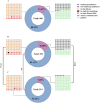Assessment of health information in Chinese atopic dermatitis-related videos: A cross-sectional study
- PMID: 40463986
- PMCID: PMC12130654
- DOI: 10.1177/20552076251346579
Assessment of health information in Chinese atopic dermatitis-related videos: A cross-sectional study
Abstract
Background: Atopic dermatitis (AD) is prevalent worldwide. People are increasingly obtaining health information through social videos. In China, the quality, reliability, understandability, and actionability of AD-related videos have yet to be fully studied.
Objective: This study proposed to analyze AD-related videos on Chinese video-sharing platforms.
Methods: Three keywords "" (atopic dermatitis) or "" (eczema) or "" (atopic eczema) were used on Bilibili and Douyin (Chinese version of TikTok) to retrieve videos from May 25 to November 25, 2024. Included videos' reliability was evaluated by the Journal of American Medical Association (JAMA) criteria and modified DISCERN (mDISCERN), quality was evaluated by Global Quality Scale (GQS), and understandability and actionability were evaluated by Patient Education Materials Assessment Tool (PEMAT). Spearman correlation was used to explore the correlation among different variables.
Results: 368 videos were included, and the activity on Douyin was higher than that on Bilibili (P < .001). Although Douyin's AD videos were rated higher than Bilibili's in reliability and understandability (all P < .001), neither of them was satisfactory. Medical practitioners were the main source of videos (n = 326, 88.59%), mostly conveying treatment (n = 159, 43.21%). The videos they uploaded had higher ratings in the JAMA, mDISCERN and understandability, and were also more popular (all P < .05). There were more videos on Bilibili that involved traditional Chinese medicine (TCM) (n = 81, 52.60%); however, the ratings of such videos were lower than those without TCM on any platform (all P < .001). Videos about treatment and prevention were almost the best two categories in terms of actionability (all P < .05). The number of likes, shares, comments, collections, fans, the JAMA score, and understandability were positively correlated (all P < .05).
Conclusions: The assessment of AD-related videos flooding social media is suboptimal. Videos from professionals are more reliable and should be promoted. The public should exercise caution when searching for healthcare information on video platforms.
Keywords: Digital health; chronic; eHealth; health informatics; public health; social media.
© The Author(s) 2025.
Conflict of interest statement
The authors declared no potential conflicts of interest with respect to the research, authorship, and/or publication of this article.
Figures








Similar articles
-
Assessment of the reliability and quality of breast cancer related videos on TikTok and Bilibili: cross-sectional study in China.Front Public Health. 2024 Jan 22;11:1296386. doi: 10.3389/fpubh.2023.1296386. eCollection 2023. Front Public Health. 2024. PMID: 38317686 Free PMC article.
-
Quality Assessment of TikTok as a Source of Information About Mitral Valve Regurgitation in China: Cross-Sectional Study.J Med Internet Res. 2024 Aug 20;26:e55403. doi: 10.2196/55403. J Med Internet Res. 2024. PMID: 39163110 Free PMC article.
-
Video Quality Assessment and Analysis of Gastroesophageal Reflux Disease on TikTok and Bilibili: Cross-Sectional Study.J Multidiscip Healthc. 2024 Dec 11;17:5927-5939. doi: 10.2147/JMDH.S485781. eCollection 2024. J Multidiscip Healthc. 2024. PMID: 39678716 Free PMC article.
-
Quality and Reliability of Liver Cancer-Related Short Chinese Videos on TikTok and Bilibili: Cross-Sectional Content Analysis Study.J Med Internet Res. 2023 Jul 5;25:e47210. doi: 10.2196/47210. J Med Internet Res. 2023. PMID: 37405825 Free PMC article.
-
Evaluation of the understandability, actionability and reliability of YouTube videos for brain, head, and neck cancer information.Eur J Oncol Nurs. 2024 Jun;70:102605. doi: 10.1016/j.ejon.2024.102605. Epub 2024 May 8. Eur J Oncol Nurs. 2024. PMID: 38795450 Review.
References
-
- Zhou J, Chen H, Zhou S, et al. Trends in atopic dermatitis prevalence among the Chinese population (1990–2021) with projections for 2022–2030. Pediatr Allergy Immunol 2024; 35: e14271. - PubMed
-
- Atopic Dermatitis Working Group, Immunology Group, Chinese Society of Dermatology. Guideline for diagnosis and treatment of atopic dermatitis in China (2020). Chin J Dermatol 2020; 53: 81–88.
LinkOut - more resources
Full Text Sources

